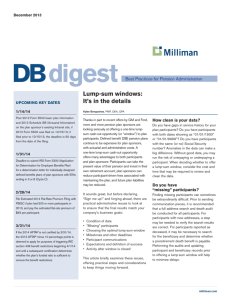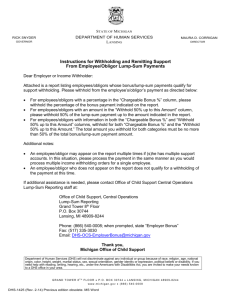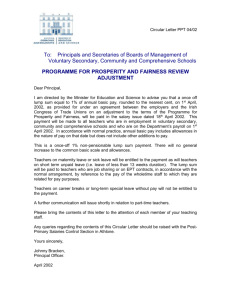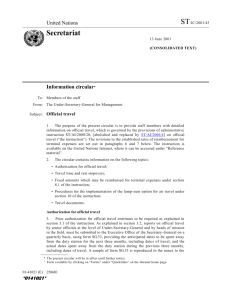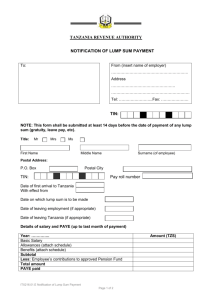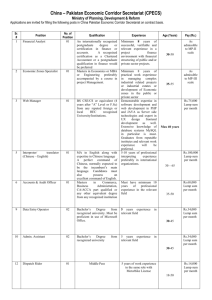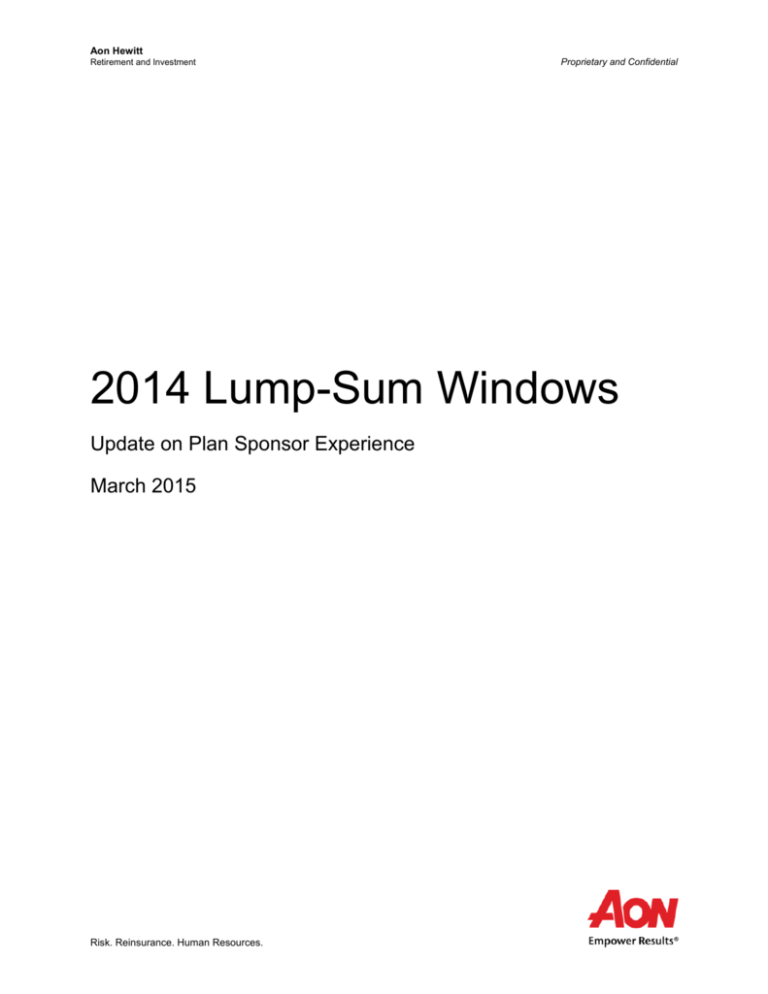
Aon Hewitt
Retirement and Investment
Proprietary and Confidential
2014 Lump-Sum Windows
Update on Plan Sponsor Experience
March 2015
Risk. Reinsurance. Human Resources.
Aon Hewitt
Retirement and Investment
Proprietary and Confidential
Overview
Offering lump-sum windows has become one of the most frequently used pension risk management
strategies of the past three years. Windows for terminated vested participants are the most common, but
retiree lump-sum windows have been offered as well.
Lump-sum windows first became prevalent in 2012 when a change in the lump-sum calculation under the
Pension Protection Act was fully implemented. We reported on our 2012 experience working with plan
sponsors in Aon Hewitt’s Pension Settlements through Terminated Vested Lump-Sum Windows, issued
in February 2013.
Plan sponsor interest in lump-sum windows continued in 2013, albeit at slightly lower levels than in 2012.
Activity increased in 2014 as a confluence of events—new mortality expectations, increased PBGC
premiums, improved funded status, movement in interest rates, extended funding relief, and additional
focus on managing pension risk—encouraged many plan sponsors to move forward with lump-sum
windows.
We expect plan sponsor interest in lump-sum windows to continue. Aon Hewitt’s 2015 Hot Topics in
Retirement survey indicated that 47% of plan sponsors are very or moderately likely to offer a terminated
vested (TV) lump-sum window in 2015, and 27% are very or moderately likely to offer a retiree lump-sum
window in 2015.
In this paper, we share experience on terminated vested lump-sum windows implemented in 2014 and
best practices for plan sponsors looking to implement future lump-sum windows. We close with a brief
summary of our experience with related settlement transactions such as cash-out sweeps, repeat lumpsum windows, “reminder” projects, and retiree lump-sum windows.
2014 Experience
We analyzed plan sponsor experience related to 70 terminated vested lump-sum windows implemented
during 2014, covering approximately 290,000 participants.
The average lump-sum election rate for these plan sponsors was 58%. Total lump-sum payments in
these windows were in excess of $4 billion, with the total lump sums offered exceeding $8 billion.
The 2014 experience reinforced many of the themes shared in previous Aon Hewitt white papers and
webinars. In particular:
The average lump-sum election rate was 58%, but individual plan sponsor experience varies widely.
Lump-sum election rates decrease as the size of the lump sum increases, but other individual
demographic data does not appear to be correlated with election percentages.
Many participants are rolling their lump sums over into IRAs, maintaining the assets within the taxqualified retirement system.
Preparation is crucial to a successful lump-sum window.
Comprehensive and easy-to-understand communications benefit both plan sponsors and plan
participants.
2014 Lump-Sum Windows
1
Aon Hewitt
Proprietary and Confidential
Retirement and Investment
Lump-Sum Election Rates
During a window, an eligible terminated vested participant can elect to receive a lump sum, commence an
immediate annuity, or defer commencement to a later date.
The average lump-sum election percentage for plan sponsors implementing a lump-sum window in 2014
was 58%. This reflects a modest increase from the average lump-sum election percentage of 55% for
plan sponsors implementing windows in 2012 and 2013.
Plan sponsor experience continues to vary between 40% and 70%, with over 80% of plan sponsors falling
in this range in 2014.
Percent of Plan Sponsors
50%
Average during 2014: 58%
Average during 2012 and 2013: 55%
40%
30%
20%
10%
0%
0%
25%
50%
Lump-Sum Election Rate
2012 - 2013 Windows
2014 Windows
75%
100%
The increase in lump-sum election rates, as well as the tightening of the distribution in our 2014
experience, coincides with an increase in the number of plan sponsors utilizing best practices. The
increase in best practice implementation leads to more successful lump-sum windows.
The remaining participants eligible for lump-sum windows either elected an annuity or deferred their
commencement. During 2014, approximately 2% of participants elected an annuity. The majority of
participants who elected an annuity were already eligible for immediate commencement of benefits.
On February 26, 2015, the Government Accountability Office (GAO) issued a report titled,
“Private Pensions: Participants Need Better Information When Offered Lump Sums That Replace
Their Lifetime Benefits.”
This report reiterated many of the key messages we have been relaying to plan sponsors for the
past several years, most notably that participants need to be engaged in the process with clear
and robust information in order to empower them to make well-informed decisions.
Plan sponsors implementing a lump-sum window should review the GAO report with counsel and
ensure they are providing participants with the necessary information in order to make a lumpsum election.
2014 Lump-Sum Windows
2
Aon Hewitt
Proprietary and Confidential
Retirement and Investment
Dollar-Weighted Lump-Sum Election Rates
The 2014 lump-sum election rate, calculated as a dollar-weighted average for plan sponsors, was 49%
(compared to 58% when not weighted by dollar amount).
As can be seen from the chart below, the lump-sum election percentage decreased as the size of the
lump sum increased.
Lump-Sum Election Percentage
Election Percentage versus Size of Lump Sum
60%
55%
50%
45%
40%
35%
30%
$0
$50,000
$100,000
Size of Lump Sum
$150,000
Each circle in the above graphic represents the lump-sum election percentage for 1,000 participants with
similar lump-sum amounts from $5,000 to $150,000. Over 97% of the participants in our study had a
lump-sum benefit of less than $150,000.
Individual Experience
Aside from the impact of lump-sum election amount, there was no meaningful correlation between other
demographic variables and the lump-sum election rate. This low level of variability was consistent with our
prior findings.
Age. Election rates for participants at different ages were similar, with the exception of large lump
sums for retirement-eligible participants. Retirement-eligible participants with a lump sum greater than
$75,000 were less likely to elect a lump sum than nonretirement-eligible participants with a lump sum
of the same size.
Employee type. Election rates for salaried, hourly nonunion, and hourly union participants were
similar. We saw slightly more variability in the lump-sum election rates for these groups compared to
our prior study; however, the differences are not statistically significant.
Gender. Election rates for male and female participants were generally the same. The election rate
for male participants was 1% higher than the election rate for female participants.
Years since termination. We saw a small decrease in lump-sum election rates as the length of time
between the date of termination and the offer date increases.
2014 Lump-Sum Windows
3
Aon Hewitt
Proprietary and Confidential
Retirement and Investment
Rollovers
Participants who elect to receive a lump sum are eligible to roll their benefit over to another tax-qualified
account such as an IRA or 401(k) plan. Participants who do not roll over their benefit are subject to taxes
on the lump sum. Further, participants under age 59½ may be subject to an additional 10% tax on the
distribution.
In our 2014 experience, approximately 55% of the participants who elected to receive a lump sum rolled
their money directly into a tax-qualified account. Participants who do not elect a direct rollover may also
roll the money over into an IRA within 60 days of the distribution, but we are not able to monitor these
rollovers.
As shown in the chart below, the rollover percentage increased as the size of the lump sum increased.
Overall, approximately 70% of the eligible dollars were rolled over into tax-qualified accounts.
Rollovers as Percentage of Lump Sums
Rollover Percentage
100%
80%
60%
40%
20%
0%
$5-$9k
$10-$29k
$30-$49k
Size of Lump Sum
$50-$99k
$100k+
The combination of a lower lump-sum election rate and a higher rollover percentage for participants with
large lump sums suggests that participants with larger benefits are more protective of their retirement
assets.
2014 Lump-Sum Windows
4
Aon Hewitt
Retirement and Investment
Proprietary and Confidential
Reminder on Best Practices
Electing to receive a lump sum as part of a one-time window is a significant decision for participants. By
following best practices, a window can lead to a positive outcome for both plan sponsors and participants.
A summary of these best practices is below, divided into two key areas of focus. First is preparation,
which is critical for plan sponsors as they put the pieces in place for a successful program. Second is the
participant experience, which is truly at the heart of the entire window project. Participants need to be
engaged in the process with clear and robust information in order to empower them to make wellinformed decisions.
Preparation
Project Management—Project management remains a significant driver of delivering a successful lumpsum window and should take into consideration a number of important areas:
Data readiness. Make an honest assessment of the quality and readiness of the data required to
offer terminated vested participants a lump sum.
Timing. Make the decision whether to move forward with a lump-sum window early enough to allow
for methodical implementation. Building in adequate time will allow the team to focus on developing
and executing a detailed and effective implementation plan.
Status updates. Hold regular status calls so that all stakeholders are well informed and the project
stays on track.
Reporting. Report on progress during the window to allow plan sponsors to monitor questions and
plan for the resulting liquidity, which can be significant.
Address Search—Address searches remain one of the most important and cost-effective strategies in
the implementation of a window. Plan participants cannot make an election without first receiving their
packages.
We recommend completing an address search on all eligible participants, rather than just those with a
“known” bad address. This additional step can potentially identify a number of additional address
changes, allowing plan sponsors to reach a larger group of eligible participants. Plan sponsors have
uncovered a significant number of new addresses using this strategy—more than 20% of the eligible
population in some cases.
We also suggest utilizing a confirmed address search that requests a response from participants to
confirm their address. This takes more time, but can also improve the quality of address data.
Despite all these efforts, we believe approximately 5% of the participants eligible for lump-sum windows
have a bad address.
Design—Plan sponsors have many design-related decisions to make as part of the lump-sum program,
such as defining the eligible group and the methodology for the lump-sum calculation. These decisions
will have an impact on the window and should be considered carefully.
2014 Lump-Sum Windows
5
Aon Hewitt
Retirement and Investment
Proprietary and Confidential
Participant Experience
Written Communication—Written communication is the primary method for informing participants of
their options and complying with regulations related to electing a pension benefit. The written
communication should be structured to accomplish a number of objectives:
Reestablish a connection with the participants. The terminated vested participants may have left the
organization many years ago, or in the case of an acquisition never have worked for the current
organization at all.
Inform the participants of their options and the pros and cons of the choices.
Focus attention on the choices, deadlines, and election requirements.
Reassure participants that help is available and provide directions to the call center.
Remind participants of the deadlines. Participants will sometimes procrastinate or lose track of the
paperwork. Reminder post cards and flyers can help focus attention on approaching deadlines.
Call Center—Call center assistance is critical for participants. The call center provides them with a
resource to receive unbiased answers to questions related to the lump-sum windows. Some plan
sponsors also add financial guidance to the call center in order to provide an additional level of
professional and unbiased support to participants.
Other Forms of Communication—We have worked with several plan sponsors to implement outbound
reminder phone calls. This is another method of engaging participants in the process and ensuring they
consider their options. Plan sponsors in 2014 that included outbound phone calls as part of their process
experienced generally higher election rates than plan sponsors that did not. Plan sponsors are continuing
to look to other methods of engaging participants in windows with strategies such as web videos, alumni
group outreach, or outbound email reminders.
Related Settlement Strategies
The main focus of our paper is terminated vested lump-sum windows. However, a high-level discussion of
the following related settlement strategies is included below:
Cash-out sweeps
Repeat lump-sum offers
Lump-sum reminder projects
Retiree lump-sum windows
Many of the terminated vested lump-sum window best practices discussed above can be applied to these
projects.
2014 Lump-Sum Windows
6
Aon Hewitt
Retirement and Investment
Proprietary and Confidential
Cash-Out Sweeps
Plan sponsors can automatically cash out participants with a lump sum of up to $5,000 if the plan
document allows. Lump-sum amounts of less than $1,000 may be automatically paid in cash to plan
participants. Participants with a lump sum between $1,000 and $5,000 may elect a cash payment or a
rollover to an IRA. Participants who do not respond to a cash-out offer must have their payment
automatically rolled over to an IRA.
Plan sponsors with an automatic cash-out threshold of less than $5,000 may wish to consider increasing
the threshold to $5,000 and running a cash-out sweep. This is a cost-effective project that can force lumpsum payments to participants with high carrying costs in relation to their liability.
Repeat Lump-Sum Offers
Plan sponsors that implemented a lump-sum window in prior years may wish to consider a second offer to
participants who declined a lump sum in the first window. There are several issues plan sponsors should
consider prior to a repeat offer, including:
Communication issues—How will participants react to a change in lump-sum amounts?
Legal issues—Do repeat offers create a “permanent” feature?
Financial issues—How many will elect the lump sum?
The communication and legal issues referenced above will likely need to be handled on a case-by-case
basis. Our limited data suggests that approximately 20% of the targeted participants accept the lump sum
during a second offer.
Many plan sponsors that implement a limited lump-sum program (for example, lump sums up to $25,000)
may offer a second lump-sum window to participants who were not included in the first window. This is a
more straightforward project with many of the same considerations as the first window.
Lump-Sum Reminder Projects
A number of plan sponsors have sent “reminder” mailings to terminated participants who already have a
lump sum available. This is different from a traditional lump-sum “window” in that the opportunity to
receive the lump sum is available at any time—not just as a one-time event. Lump-sum election
percentages for reminder projects have ranged between 20% and 30%. While smaller than the election
percentages for terminated vested lump-sum windows, the remaining 70% to 80% of participants may still
elect to take a lump sum at a later date.
Plan sponsors with a large population of terminated vested participants with an available lump sum may
wish to consider a reminder project. The administrative burden for these projects is much smaller than for
a traditional window. No plan amendment is necessary, processes for calculating the lump sum are
already well established, and existing election documents do not need to be drafted from scratch.
2014 Lump-Sum Windows
7
Aon Hewitt
Proprietary and Confidential
Retirement and Investment
Retiree Lump-Sum Windows
Plan sponsor interest in retiree lump-sum windows has also increased over the past few years. A review
of the issues and considerations associated with a retiree lump-sum program is beyond the scope of this
paper.
Information related to lump-sum election rates for retiree programs, derived from public disclosures, is
summarized in the table below.
Retiree Lump-Sum Windows (known as of February 2015)
Sponsor
Ford
General Motors
TRW Automotive
Johnson Controls
NCR
ADM
Alcatel-Lucent
Approximate Number of
Participants Offered a
Lump Sum
Year
2012–2013
2012
2012
2014
2014
2014
2015
90,000
(retirees and TVs)
42,000
(retired after 1997)
21,000
(retirees and TVs)
11,000
(retired after 1999)
20,000
(retired after 1993)
10,000
74,000
(retirees and TVs)
Approximate Number of
Retirees Taking Lump
Sum
30%
(37% including TVs)
30%
Unknown
(50% including TVs)
Not disclosed
50%
Not disclosed
Not yet complete
In Closing
Lump-sum windows and related projects continue to be an effective way for plan sponsors to manage risk
while offering participants the opportunity to consolidate their retirement savings. A well thought-out
program can lead to successful outcomes for both the plan sponsor and participants.
For more information, please contact your Aon Hewitt consultant.
2014 Lump-Sum Windows
8
Aon Hewitt
Retirement and Investment
Proprietary and Confidential
Contact Information
Chris Birch
Partner
Retirement and Investment
+1.312.381.7208
chris.birch@aonhewitt.com
Grant Martin
Retirement and Investment
+1.415.486.6947
grant.martin@aonhewitt.com
2014 Lump-Sum Windows
9
Aon Hewitt
Retirement and Investment
Proprietary and Confidential
About Aon Hewitt
Aon Hewitt empowers organizations and individuals to secure a better future
through innovative talent, retirement, and health solutions. We advise, design, and
execute a wide range of solutions that enable clients to cultivate talent to drive
organizational and personal performance and growth, navigate retirement risk
while providing new levels of financial security, and redefine health solutions for
greater choice, affordability, and wellness. Aon Hewitt is the global leader in human
resource solutions, with over 30,000 professionals in 90 countries serving more
than 20,000 clients worldwide. For more information, please visit aonhewitt.com.
© Aon plc 2015. All rights reserved.
2014 Lump-Sum Windows
10


